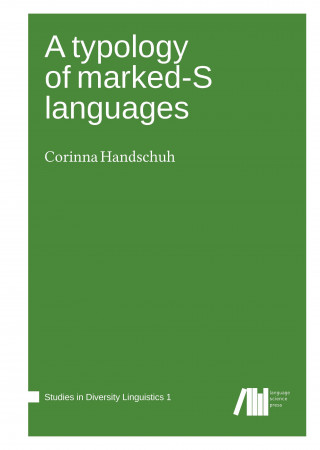
Kod: 12826103
A typology of marked-S languages
Autor Corinna Handschuh
Case-systems all over the world exhibit striking similarities. In most languages intransitive subjects (S) receives less overt marking than one of the two transitive arguments (agent-like A or patient-like P); the other one of the ... więcej
- Język:
 Angielski
Angielski - Oprawa: Twarda
- Liczba stron: 280
Wydawca: Language Science Press, 2015
- Więcej informacji o książce

129.80 zł
Zwykle: 136.70 zł
Oszczędzasz 6.90 zł

Dostępna u dostawcy
Wysyłamy za 7 - 9 dni
Zobacz książki o podobnej tematyce
-

Messages
50.99 zł
Podaruj tę książkę jeszcze dziś
- Zamów książkę i wybierz "Wyślij jako prezent".
- Natychmiast wyślemy Ci bon podarunkowy, który możesz przekazać adresatowi prezentu.
- Książka zostanie wysłana do adresata, a Ty o nic nie musisz się martwić.
Więcej informacji o A typology of marked-S languages
Za ten zakup dostaniesz 76 punkty
 Opis
Opis
Case-systems all over the world exhibit striking similarities. In most languages intransitive subjects (S) receives less overt marking than one of the two transitive arguments (agent-like A or patient-like P); the other one of these two arguments is usually encoded by the same form as S. In some languages the amount of overt marking is identical between S, A, and P. But hardly ever does the S argument receive more overt marking than A or P. Yet there are some languages that do not follow this general pattern. This book is about those languages that behave differently, the marked-S languages. Marked-S languages are well-known to be found in East Africa, where they occur in two different language families, Afro-Asiatic and Nilo-Saharan. They can also be found in North-Western America and the Pacific region. This book is the first investigation of marked S-languages that treats the phenomenon on a global scale. The study examines the functional distribution of the two main case-forms, the form used for S (S-case) and the case-form of the transitive argument which receives less marking (the zero-case). It offers a very fine-grained perspective considering a wide range of constructions. The contexts in which the case-marking patterns are investigated include nominal, existential and locational predication, subjects in special discourse function (e.g. focused constituents), subjects of passives and dependent clauses, as well as the forms used for addressing someone (vocative form) and for using a noun in isolation (citation form). Apart from the functional distribution of case forms, the formal means of marking are also considered. The main focus is on the synchronic description and comparison of marked-S languages, but historical explanations for the unusual case-marking pattern are also discussed.
 Szczegóły książki
Szczegóły książki
129.80 zł
- Pełny tytuł: A typology of marked-S languages
- Autor: Corinna Handschuh
- Język:
 Angielski
Angielski - Oprawa: Twarda
- Liczba stron: 280
- EAN: 9783944675701
- ISBN: 3944675703
- ID: 12826103
- Wydawca: Language Science Press
- Waga: 654 g
- Wymiary: 240 × 170 × 19 mm
- Data wydania: 10. July 2015
Ulubione w innej kategorii
-

Dune
34.73 zł -33 % -

Haunting Adeline
125.38 zł -1 % -

Berserk Deluxe Volume 2
211.92 zł -1 % -

White Nights
15.25 zł -23 % -

Powerless
48.58 zł -11 % -

Atomic Habits
57.31 zł -28 % -

Dune Messiah
46.17 zł -3 % -

Berserk Deluxe Volume 3
217.44 zł -3 % -

One Day
32.52 zł -36 % -

Berserk Deluxe Volume 1
211.12 zł -2 % -

Iron Flame
60.93 zł -28 % -

Surrounded by Idiots
36.63 zł -28 % -

Harry Potter and the Prisoner of Azkaban (Minalima Edition)
169.86 zł -2 % -

Gravity Falls Journal 3
89.14 zł -

Heaven Official's Blessing: Tian Guan Ci Fu (Novel) Vol. 1
85.32 zł -5 % -

The Creative Act
99.88 zł -15 % -

Dune
47.18 zł -23 % -

Hunting Adeline
126.08 zł -4 % -

A Little Life
46.87 zł -14 % -

Children of Dune
46.57 zł -2 % -

Heaven Official's Blessing: Tian Guan Ci Fu (Novel) Vol. 2
77.49 zł -14 % -

Bungo Stray Dogs, Vol. 8 (light novel)
65.55 zł -4 % -

Percy Jackson and the Olympians 5 Book Paperback Boxed Set
184.92 zł -4 % -

Solo Leveling, Vol. 1
86.43 zł -3 % -

The Prisoner's Throne
44.76 zł -12 % -

Court of Thorns and Roses
43.26 zł -15 % -

Cry Baby Coloring Book
47.18 zł -1 % -

Fourth Wing
73.68 zł -12 % -

Icebreaker
35.03 zł -26 % -

Berserk Deluxe Volume 6
217.44 zł -3 % -

Avatar, the Last Airbender: The Kyoshi Novels (Box Set)
168.65 zł -2 % -

The 48 Laws of Power
100.58 zł -12 % -

House of Leaves
123.67 zł -3 % -

Twisted Lies
37.64 zł -26 % -

Dune Messiah
49.48 zł -13 % -

No Longer Human
58.32 zł -5 % -

48 Laws Of Power
60.93 zł -28 % -

Twisted Games
37.64 zł -26 % -

Caraval Paperback Boxed Set
174.98 zł -3 % -

Solo Leveling, Vol. 2
80.10 zł -17 % -

Open Circuits
169.05 zł -2 % -

Berserk Deluxe Volume 5
156 zł -30 % -

Heaven Official's Blessing: Tian Guan Ci Fu (Novel) Vol. 3
79.20 zł -12 % -

Berserk Deluxe Volume 4
200.68 zł -11 % -

Court of Mist and Fury
36.43 zł -26 % -

SOLO LEVELING V08
88.14 zł -2 % -

English File Upper Intermediate Multipack A (4th)
100.28 zł -

CHAINSAW MAN V14
43.46 zł -21 % -

Before the Coffee Gets Cold
33.82 zł -26 %
zadowolonych klientów
Od roku 2008 obsłużyliśmy wielu miłośników książek, ale dla nas każdy był tym wyjątkowym.
Copyright! ©2008-24 libristo.pl Wszelkie prawa zastrzeżonePrywatnieCookies


 21 milionów książek
21 milionów książek Dostawa 10.99 zł
Dostawa 10.99 zł (32) 444 93 66 (8-15.30h)
(32) 444 93 66 (8-15.30h)